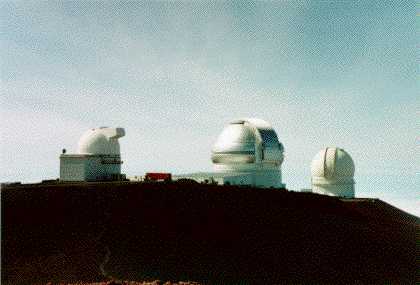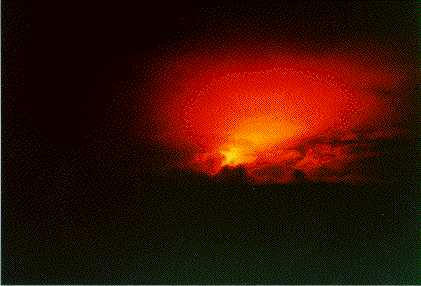|
Big Island and Volcanoes |
|

|
ig Island is big! As an equilateral triangle roughly ninety miles to the side, it sports a diverse assortment of natural scenery that has much to offer the outdoors-oriented traveler. The most popular destination is Volcanoes National Park with a treasure trove of geological wonders to excite and inspire.
Two huge volcanoes lie interior - Mauna Kea ("White Mountain") and Mauna Loa ("Broad Mountain"). At nearly 14,000 feet these two volcanoes are often snowcapped - so contrasting with both the rain-drenched tropical rainforest below and the standard concept of what most imagine when Hawaii comes to mind. Three additional volcanoes round out the landmass, including the most consistently active volcano on earth, Kilauea.
To ensure a full-scale exploration I would visit all three tips of Big Island and the summits of both Mauna Kea and Mauna Loa.

|
|
Mauna Loa from the north with its shallow slopes and disarmingly benign appearance. In truth it is a giant, active volcano. |
Hilo is on the damp east coast, Kona on the dry west coast. For the resort enthusiast that sums up Big Island. In contrast, and having landed at the Kona Airport, I immediately left the city bound for Volcanoes National Park - driving along route 11 as it curves around the southern coastline. The road climbs through several small towns to perhaps 1,500 feet, providing good views of the sun-drenched beaches.
A chilled Starbucks iced coffee with chocolate caramel bar from a roadside store enlivened me to continue onto my afternoon's destination at the Visitors Center in Volcanoes National Park. There I would gather information for a climb of Mauna Loa.
Mauna Loa is replete with superlatives. To comprehend and appreciate Mauna Loa, a review of the relevant geology is given here.
Mauna Loa, Mauna Kea and Hawaiian GeologyBig Island, and indeed, all of the Hawaiian islands, was created as the Pacific tectonic plate slowly migrated northwest over a hot spot" where magma vents from earth's interior. A shield volcano is formed as the cooled lava from the hot spot builds upon itself in a layered fashion. Big Island resulted from the consolidation of five volcanoes created like this.
Mauna Loa is the broadest and most voluminous of these volcanoes. Its base is three miles beneath the ocean's surface - and rises to an elevation of 13,677 feet. It has a very gentle slope, so gentle in fact, that it hardly looks like a mountain at all when viewed from a distance. However Mauna Loa contains more volume than any other mountain on earth as measured from its subterranean base. With 10,000 cubic miles of rock, it contains more volume that the entire Sierra Nevada range in California!

|
|
The astronomical observatories on Mauna Kea's summit house some of the largest telescopes in the world. |
Mauna Loa is only about 100 feet lower than its sister peak Mauna Kea. At 13,796 feet, Mauna Kea is often claimed to be the tallest mountain on earth as measured from its base. It is home to several world-class telescopes located near its summit. The astronomical community carefully chose Big Island for its largest ground-based instruments owing to the large fraction of clear nights at these summit elevations, some eighty percent. Furthermore, the relative lack of water vapor compared to that found at lower elevations aids infrared astronomony.
I had climbed Mauna Kea several years earlier with a close friend, Edward Earl, also of San Diego, California. Rather than simply drive up the service road to the summit, we made an overnight backpack from the Onizuka Center for International Astronomy at the nine thousand foot level.
In contrast, one cannot simply drive up Mauna Loa (thank goodness). First, it is an active volcano which continues to spit fire and threaten communities. Second, a road is useless since there are no human activities at its summit. And, of course, it would be a pity to mar this unique mountain with a new road that would inevitably bring throngs of tourists who would not appreciate the effort required to climb a mountain in self-propelled fashion.
As I entered Volcanoes National Park there was a yellow and bluish tint to some clouds, the air smelling crisp and burnt. The south slope of Mauna Loa was on fire - a fact soon confirmed at the Visitor Center. Despite the fire threat, Park rangers were willing to issue me a permit for a three or four day ascent of Mauna Loa. I was uncomfortable with returning from the summit only to be blocked by a wildfire.
So I defaulted to "plan B", an ascent from the north side requiring one day. You are asking, why would I have preferred a route that takes four days in the first place? Because Mauna Loa deserves to be climbed the "right way", i.e. by a route whose duration and overall physical effort is appropriate for a mountain of this scale.
In life personal rewards scale with the effort, and when relevant, with the degrees of danger and of difficulty. I view mountain climbing as the most physical manifestation of striving for a goal. Hence in climbing this concept of risk versus reward applies in ample measure.

|
|
The sky glows orange during an eruption of Kilauea. The lava flows in tubes to the sea and forms new land in the process. |
A one day ascent left me feeling cheated from a more fulfilling Mauna Loa experience. However it would free up valuable time to explore other aspects of Big Island.
Although I had previously explored Volcanoes National Park with Edward Earl, I enjoyed once again the Rim Drive around Kilauea Caldera. Kilauea is the most consistently active volcano in the world. From its fiery interior lava has been spouting continually for decades. It is also the most thoroughly studied volcano on earth.
I drove to one of the two free campgrounds in the Park, Namakani Paio, and ate a cold supper since my stove was malfunctioning. At camp I met a German lady down on her luck. She was obviously trying her best to engage me in conversation - and I soon realized why: she had no vehicle and yet wanted to visit the active lava flows by dark.
Going along with her facade of interest in me, after supper I drove with her down the Chain of Craters Road to the seacoast. There, after sunset for heightened visual effect, one spies orange lava flowing oceanward. New land is created before final trickles are quenched in the Pacific. Indeed, you can walk past rocks that have solidified so recently, the warmth radiating from them feels like sunshine on your face.
A truly inspiring experience provided by Pele, the Hawaiian volcano goddess. In a sort of anticlimax that left me feeling empty, we returned the twenty miles to our campground and I slept by ten o'clock.
| previous page - Hana Road and Lahaina | next page - Mauna Loa |